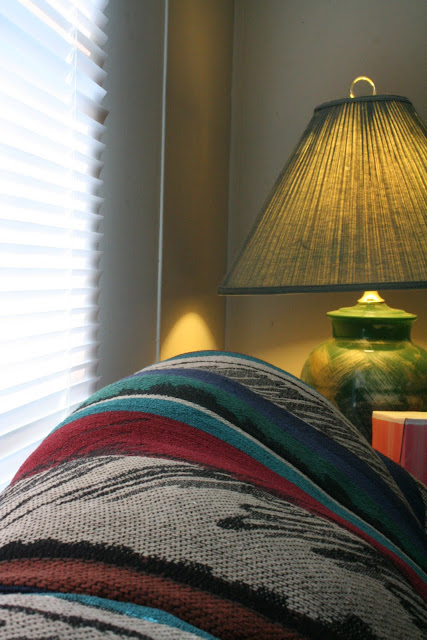Yesterday, I attempted to explain exactly what the aperture is and how it is measured. I even showed you how to find it on your camera, if you are so inclined.
Here's a quick review:
 |
| Set camera mode to Aperture priority |
 |
| Scroll to the preferred aperture setting |
Most importantly, remember that the number you see is the bottom number of a fraction. If I recall my mathematics correctly, that means that the bigger the number, the smaller the opening. Correct??
Is everyone sufficiently confused?? GOOD! :)
Now comes the fun part - How does it affect my photos and why should I pay attention to it?
(for these examples, I took a couple of quick shots of my sofa. It is old and needs recovered, so don't laugh!)
 |
| Photo taken with a smaller aperture (larger number - 11) |
 |
| Photo taken with a larger aperture (smaller number - 4.5) |
The aperture affects the "
depth of field" of your photo. In other words, it affects which things are in focus. Notice that in the upper photo with the smaller aperture, the photo is nearly in focus all the way from front to back (the stuff close to me and the stuff far away from me.) In the lower photo, the things closest to me and the lamp that is the furthest away are thrown out of focus. They have a nice blur and the only area in focus is the area of the sofa where I focused.
So, why would this be important to know? When would you want things out of focus??
Depth of field mimics the way our eyes naturally work, especially when looking at small things or things that are very close. I actually remember noticing this at a very young age. I remember laying on my grandmother's bed when I was supposed to be napping - but wasn't. I would look at the bracelet on my wrist and notice that the curtains were blurry. Then I would look at the curtains across the room and notice that my wrist and bracelet were blurry. Have you ever done that??
I was discussing this with my father a couple of months ago, when he commented about how he preferred that all things in a photo be in crisp, clear focus. While I agree with him to an extent, there are times when you might want the background to be out of focus.
Here are some examples:
 |
| If the background were in focus, you would have trouble seeing the spider's web. |
 |
| If the flowers were in focus, we might not notice the bubbling water fountain. |
 |
| It can negate a distracting or unattractive background |
 |
| It can also pull your attention to what you want to emphasize most! (ps - you can barely see the overhead powerline because of this!) |
|
Again, this post is getting too long! You can talk a lot about aperture and still have so much left to say. I can see why all the photography sites talk about it so much! All of my pictures today have dealt with a large aperture which produced a shallow depth of field. Maybe tomorrow I will work to show you shots with a smaller aperture.
Have a great Thursday!
Tiffany

































2 comments:
A very informative lesson! Thanks!
Thak you Tiffany. There is so much I don't know about cameras and today I made a big foray into the world of all things digital and bought a camera plus 4 lenses on eBay. I may very well contact you and ask you for your definitions of the apparatus I have just purchased. Beware!
Post a Comment